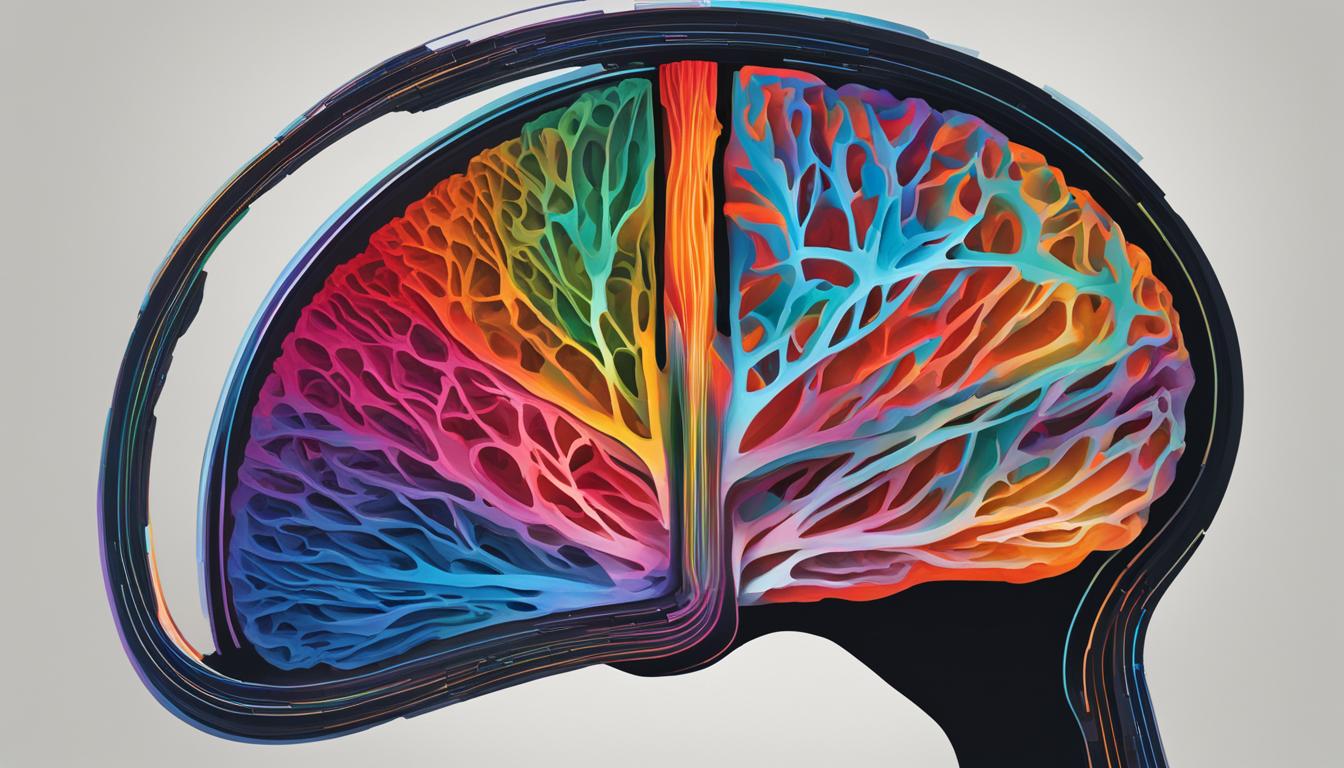When it comes to personal development and learning, the brain and mindset are intrinsically connected. Our brain’s ability to adapt and change, known as neuroplasticity, plays a vital role in shaping our mindset. By understanding this interplay, we can harness the power of our mindset for growth and self-improvement.
Key Takeaways:
- The brain and mindset have a dynamic relationship influenced by neuroplasticity.
- Neuroplasticity refers to the brain’s ability to change and adapt based on experiences.
- Our mindset is our mental attitude and includes how we perceive ourselves, our circumstances, and change.
- A growth mindset focuses on development and learning, while a fixed mindset believes abilities are fixed.
- Understanding the brain-mindset relationship empowers us to cultivate a growth mindset for personal growth.
The Brain’s Role in Shaping Mindset
Our brains are remarkable organs that possess the incredible ability to adapt and change. This characteristic, known as neuroplasticity, plays a fundamental role in shaping our mindset. Neuroplasticity allows our brains to create new neural connections, facilitating learning, resilience, and personal transformation.
A growth mindset is rooted in the belief that abilities and intelligence can be developed through effort and perseverance. When we embrace a growth mindset, our brains become primed for growth and change. We actively seek out new knowledge, tackle challenges head-on, and view failures as opportunities for learning and improvement.
By leveraging neuroplasticity, a growth mindset enables us to cultivate resilience and transform our lives. Instead of being limited by a fixed mindset that views abilities as set in stone, a growth mindset encourages us to continuously push our boundaries and expand our potential. It empowers us to unlock new talents, develop new skills, and achieve personal growth in ways we never thought possible.
| Benefits of a Growth Mindset | Differences with a Fixed Mindset |
|---|---|
| 1. Increased motivation and drive | 1. Belief that abilities are fixed and unchangeable |
| 2. Embracing challenges as opportunities for growth | 2. Avoidance of challenges due to fear of failure |
| 3. Persistence and resilience in the face of setbacks | 3. Giving up easily when faced with obstacles |
| 4. Openness to feedback and constructive criticism | 4. Resistance to feedback and fear of criticism |
| 5. Continuous learning and self-improvement | 5. Stagnation and reluctance to learn new things |
In summary, our brains have the extraordinary power to shape our mindset through neuroplasticity. By adopting a growth mindset, we can harness this power to cultivate resilience, embrace challenges, and unlock our true potential. The combination of neuroplasticity and a growth mindset paves the way for personal transformation, lifelong learning, and endless possibilities.

Enhancing Resilience and Personal Development through Mindset
Our mindset plays a critical role in enhancing resilience and personal development. By changing the way we perceive our surroundings and adopting a growth mindset, we can amplify our resilience and positively influence how our brain works under pressure.
One key aspect is big picture thinking. When faced with challenges, it’s important to step back and view the situation from a broader perspective. This allows us to see the potential opportunities and lessons within the setback, enabling us to approach it with a growth mindset. By reframing our perception, we can transform adversity into a catalyst for growth and personal development.
Another powerful tool is positive self-talk. Our inner dialogue greatly influences our mindset and, consequently, our brain’s response to challenges. By consciously cultivating positive self-talk, we can build resilience and confidence. Affirming our abilities, focusing on our strengths, and acknowledging our progress can help rewire our brain to embrace a growth mindset.
Journaling is also an effective practice for self-improvement and mindset enhancement. By writing down our thoughts, feelings, and experiences, we gain clarity and insight. We can identify patterns, challenges, and areas of growth. Journaling allows us to reflect, learn from our experiences, and set goals for personal development. It becomes a powerful tool to leverage neuroplasticity and cultivate a growth-oriented mindset.
Ultimately, choosing to adopt a growth mindset is a transformative decision. By actively shifting our mindset and implementing strategies like perception reframing, positive self-talk, and journaling, we can enhance our resilience, stimulate our personal development, and unlock our full potential. Embracing the power of our mindset empowers us to navigate challenges with strength and perseverance, paving the way for growth and self-improvement.
FAQ
What is neuroplasticity?
Neuroplasticity refers to the brain’s ability to change and adapt based on our experiences. It allows the brain to create new neural connections and facilitates learning, resilience, and personal development.
What is a growth mindset?
A growth mindset is the belief that abilities and intelligence can be developed with effort and perseverance. It stimulates the brain to create new neural connections and allows for personal growth and transformation.
How can mindset enhance resilience?
By adopting a growth mindset and changing the way we perceive our surroundings, we can amplify our resilience. Strategies such as viewing events as learning opportunities, maintaining perspective, and focusing on what is going right can shape our mindset and positively influence how our brain works under pressure.
How can I cultivate a growth mindset?
Actively engaging in self-improvement and learning, embracing challenges as opportunities for growth, and leveraging neuroplasticity can facilitate personal development and foster a growth mindset. By choosing to shift our mindset, we can actively shape our future and unlock our full potential.

Leave a Reply